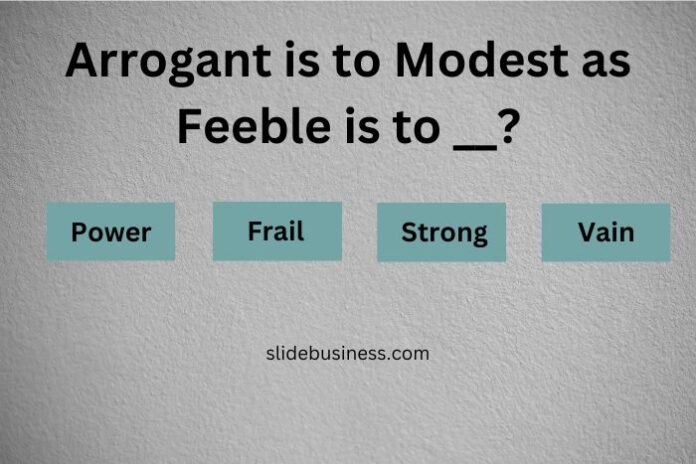‘Arrogant is to modest as feeble is to __?’ If you have stumbled upon this phrase and find yourself scratching your head, you are in the right place.
In this article, we’ll unravel this comparison, breaking it down into simple terms that are easy to grasp. Whether you are a lover of language, a student, or just curious, you are surely going to find this post helpful. We will show you what the analogy means and instances where it is often used.
However, if you are in a rush, the full expression of the analogy is ‘Arrogant is to modest as feeble is to strong’ Now, let’s explain why it’s so!
Arrogant is to Modest as Feeble is to ___?
As we already said, the complete expression of the analogy is “Arrogant is to modest as feeble is to Strong or Robust.”
This analogy works by comparing two pairs of antonyms.
“Arrogant” and “Modest” are opposites. Being arrogant means having an exaggerated sense of one’s abilities or importance, while being modest means having a humble estimate of one’s merits, importance, etc.
In the same way, “Feeble” and “Robust” (or “Strong”) are opposites. “Feeble” refers to lacking physical strength, vigor, or vitality; being weak. On the other hand, “Robust” or “Strong” indicates a strong, healthy, or hardy state.
Thus, the analogy draws a parallel between two sets of contrasting qualities: one set related to attitude or character (arrogance vs. modesty), and the other related to physical or metaphorical strength (feebleness vs. robustness/strength).
More Analogies Explained!
Tragedy is to sadness as opposition is to __
Now that we understand the analogy, ‘Arrogant is to modest as feeble is to strong,’ let’s consider some more of such analogies and what they mean.
So, let’s look at ‘Tragedy is to sadness as opposition is to debate.’ This analogy compares the relationship between tragedy and sadness to that of opposition and debate. A tragedy often leads to sadness, just as opposition naturally leads to debate.
Imagine a community facing a tragic event, like a natural disaster. The tragedy brings collective sadness. In a different scenario, in a town hall meeting, when a new policy faces opposition, it naturally sparks a debate. This analogy is used to show how one situation inherently leads to a specific emotional or social response.
Doubt is to suspicion as confidence is to __
The complete version of the analogy is ‘Doubt is to suspicion as confidence is to certainty.’ Again, this analogy draws a parallel between doubt leading to suspicion and confidence leading to certainty.
Doubt involves a lack of trust or certainty, which can escalate to suspicion, a stronger feeling of mistrust or questioning. Similarly, confidence, a belief in oneself, often leads to certainty, a state of being sure.
In a workplace scenario, if a manager doubts an employee’s ability, it can turn into suspicion about their competence. Conversely, confidence in a project’s success often leads to certainty about positive outcomes.
Uncertainty is to hesitation as error is to __
The expression is ‘Uncertainty is to hesitation as error is to inaccuracy.’ Here, the relationship between uncertainty and hesitation is compared to that between error and inaccuracy.
Uncertainty, or not being sure, often causes hesitation, a delay due to indecision. Similarly, an error, a mistake, often leads to inaccuracy, a lack of correctness.
Nuisance is to pest as worry is to concern
This analogy relates nuisance to pest and worry to concern. A nuisance, something annoying, is like a pest, a bothersome creature. Similarly, worry, a state of anxiety, is like concern, a state of care or attention about something.
For example, in a garden, insects can be a nuisance, much like pests damaging plants. In life, small worries about daily tasks can escalate into larger concerns about overall well-being.
Disagreement is to argument as mishap is to accident
In this analogy, disagreement leads to an argument, just as mishap leads to the accident. Disagreement, a difference in opinion, often results in an argument, a verbal dispute. Similarly, a mishap, a minor mistake or oversight, can lead to an accident, an unintended event with potentially harmful results.
Crocodile is to reptile as oxygen is to element
This analogy is about categorization. A crocodile is a type of reptile, just as oxygen is a type of element. In biology class, students learn that crocodiles are part of the larger group of reptiles, which also include snakes and lizards. In chemistry, students learn that oxygen is one element among many in the periodic table.
So, What is An Analogy?
So far, we have not only helped you see the complete version and explaination of the analogy, ‘Arrogant is to modest as feeble is to strong’ but we have also explained some other similar analogies.
Now, you may be wondering what is an analogy in the first place. Well, an analogy is a comparison between two things, typically for the purpose of explanation or clarification. It’s a linguistic tool that draws a parallel between two different objects, concepts, or situations, highlighting similarities in their relationships, structure, or function.
Analogies are often used to make complex or unfamiliar ideas easier to understand by relating them to something known and more straightforward. They play a significant role in problem-solving, decision-making, and communication, helping to illuminate concepts by drawing connections and contrasts.
Analogies are prevalent in everyday language, literature, education, and various fields of study. They serve as a bridge to connect different ideas and enhance comprehension.
Related Articles You Might Like:







